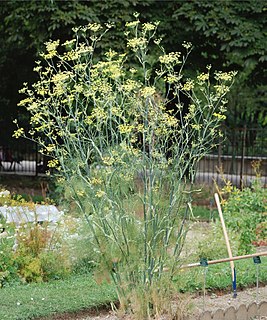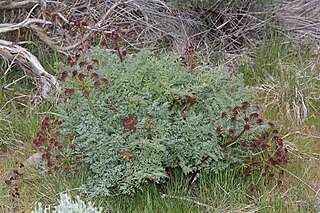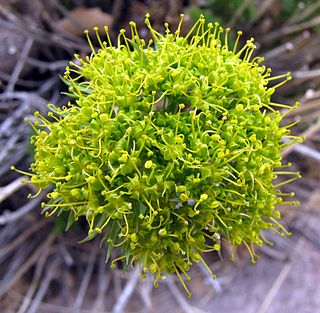
Fennel is a flowering plant species in the carrot family. It is a hardy, perennial herb with yellow flowers and feathery leaves. It is indigenous to the shores of the Mediterranean but has become widely naturalized in many parts of the world, especially on dry soils near the sea-coast and on riverbanks.

Lomatium is a genus of about 75 species of perennial herbs native to western North America; its common names include biscuitroot, Indian parsley, and desert parsley. It is in the family Apiaceae and therefore related to many familiar edible species such as carrots and celery; some Lomatium species are extensively used by Native Americans in the inland Northwest as a staple food.

Lomatium dissectum is a species of flowering plant in the carrot family known by the common name fernleaf biscuitroot. It is native to much of western North America, where it grows in varied habitat. It is found in the eastern slopes of the Cascade Range, Rocky Mountains, Klamath Mountains, eastern Transverse Ranges and the Sierra Nevada in California.

Lomatium macrocarpum is a perennial flowering plant in the carrot family known by the common names bigseed lomatium, biscuit root or bigseed biscuitroot. It is native to much of western North America, where it can be found in various types of habitat, including the grasslands of the Great Plains. It is spreading or erect perennial herb growing up to about half a meter long with hairy, gray-green herbage. The leaves are up to about 24 centimeters long and are intricately divided into many small, narrow segments. The inflorescence bears an umbel of yellowish, purplish, or white flowers. The fruit is a compressed, winged, round or oval disc up to about 2 centimeters long.

Lomatium californicum is a species of plant related to the carrot and the parsnip which is known by the common names California rock parsnip, celery weed, and California lomatium.

Adobe parsley, also known as adobe lomatium and rose-flowered desert-parsley, is a very rare plant of the Western U.S., known only from northwestern Nevada and southeastern Oregon, and which may also occur in northeastern California. The largest populations occur on the Sheldon National Wildlife Refuge. It is a member of the celery family, the Umbelliferae, and has yellow flowers.

Cephalanthera austiniae is a species of orchid known as the phantom orchid and snow orchid because the entire plant is white except for a few yellow markings on the flowers.

Lomatium parryi, commonly known as Parry's biscuitroot and Utah desertparsley, is a perennial herb in the carrot family. It is a common herb in high altitude areas of deserts and common in desert National parks, such as Death Valley mountains, in the western part of the United States.

Lomatium bradshawii, also known as Bradshaw's desert parsley, is an endangered perennial herb native to Oregon and Washington, United States. Lomatium bradshawii was thought to be extinct until 1979, when it was rediscovered by a University of Oregon graduate. This herb was common in the Willamette Valley before agricultural development and fire prevention which has allowed shrubs and weeds to invade. Most known populations of Lomatium bradshawii are within ten miles of Eugene, Oregon. In the Willamette Valley, populations exist in the Oregon counties Lane, Benton, Linn, and Marion, and in Washington Lomatium bradshawii grows in Puget Sound. The largest population of this herb is in Camas Meadows, Washington, with a population of 10,7900,00 +/- 2,010,000, and the Berry Botanic Garden keeps a seedbank.
Lomatium cusickii is a perennial herb of the family Apiaceae. Its range is in the Northwestern United States.

Lomatium grayi, commonly known as Gray's biscuitroot, Gray's desert parsley, or pungent desert parsley, is a perennial herb of the family Apiaceae. It is native to Western Canada in British Columbia, and the Western United States, including from the Eastern Cascades and northeastern California to the Rocky Mountains.
Lomatium ciliolatum is a species of flowering plant in the carrot family known by the common name Yolla Bolly biscuitroot. It is endemic to California, where it is known from the mountain ranges adjacent to the north and south of the San Francisco Bay Area, at 300–600 feet, 1200–2100 m. It is often a member of the serpentine soils flora in woodland and chaparral habitat.

Lomatium howellii is an uncommon species of flowering plant in the carrot family known by the common name Howell's biscuitroot, or Howell's lomatium. It is native to the Klamath Mountains of southern Oregon and northern California, where it is a member of the local serpentine soils flora.
Lomatium marginatum is a species of flowering plant in the carrot family known by the common name butte desertparsley. It is endemic to California, where it is known from mountains, valley, and grassland habitat, including serpentine, in the northern half of the state. It is a perennial herb growing up to about half a meter tall from a small taproot. There is no stem, and the leaves and inflorescence emerge from ground level. The purple-green leaves may approach 30 centimeters long, their blades divided into many long, narrow segments. The short but wide inflorescence bears an umbel of yellowish, purplish, or reddish flowers. The Lomatium marginatum is not currently an endangered species.

Lomatium stebbinsii, known by the common name Stebbins' desertparsley, is a rare species of flowering plant in the carrot family.

Lomatium triternatum is a species of flowering plant in the carrot family known by the common name nineleaf biscuitroot. It is native to western North America from British Columbia to California to Colorado, where it grows in many types of habitat. It is a hairy perennial herb growing up to a meter tall from a taproot. The leaves emerge from the lower part of the stem. Each is generally divided into three leaflets which are each subdivided into three linear leaflike segments. The inflorescence is an umbel of yellow flowers, each cluster on a ray up to 10 centimeters long.
Plagiobothrys austiniae is a species of flowering plant in the borage family known by the common name Austin's popcornflower. It is native to California, where it can be found in the Central Valley and Sierra Nevada foothills. It is also known from southern Oregon.

Lomatium plummerae is a formerly recognized species of plant in the carrot family (Apiaceae). When recognized, it was subdivided into a number of subspecies and varieties. As of August 2021, Plants of the World Online considers the species itself and the variety helleri to be synonyms of Lomatium donnellii, and the varieties austiniae and sonnei as synonyms of Lomatium austiniae, whereas the Jepson eFlora considers the species and the varieties austiniae and sonnei to be synonyms of Lomatium donnellii.
Rebecca Merritt Smith Leonard Austin was an amateur botanist and naturalist who collected and sold native plants in California and Oregon. Lomatium austiniae and Cephalanthera austiniae are named in her honor. She studied the chemistry, natural history of, and insects captured by the carnivorous pitcher plant Darlingtonia californica, and sold collected specimens to botanists and collectors. Her specimens are included in the collections of the Smithsonian Institution and the California Academy of Sciences.













